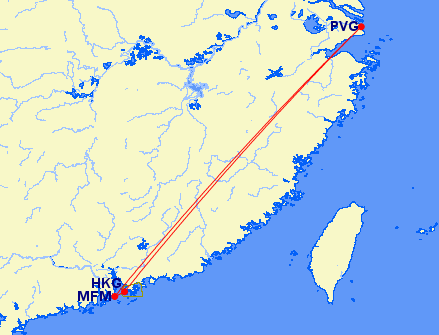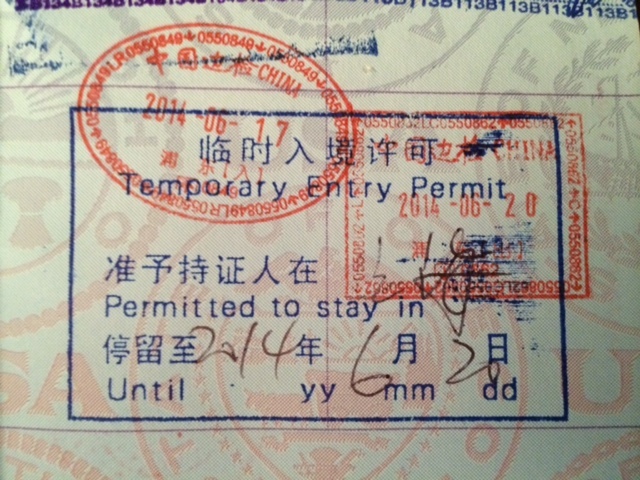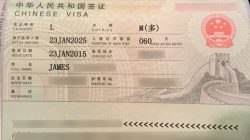When I took my sister to Southeast Asia for the first time last month, I wanted to visit several new destinations. Hong Kong was still on the list. We just connected through Bangkok without leaving the airport. But Chiang Mai, Siem Reap, Shanghai, and Macau were all new to me. In fact, any part of mainland China would have been new.
I’m not especially keen on paying for a visa. It’s why I hadn’t yet visited China and why I still have yet to visit some places — like Brazil — that charge over $100 to get in. Brazil actually lets you get a visa for up to 10 years, so that isn’t too bad. But I don’t think I do enough international travel to amortize that cost very quickly. China, on the other hand, limits a tourist visa to 12 months and requires information about your outbound and return flights. I didn’t book our return tickets until after we left the U.S., and I thought it potentially unwise to book a refundable ticket just to get our visas approved and cancel it later.
So I decided to take advantage of a relatively recent policy that allows citizens of the U.S. and many other countries to visit certain cities for up to 72 hours without a visa, called “Transit without Visa” or TWOV. The main requirement of TWOV is that you must be arriving from Country A and departing to Country B, thus making China a point of “transit” rather than your destination. San Francisco to Beijing to Tokyo is okay even if you continue from Tokyo back to the U.S.; San Francisco to Beijing to Seattle is not okay. Qualifying airports in China include:
- Beijing (PEK)
- Chengdu (CTU)
- Chongqing (CKG)
- Dalian (DLC)
- Shanghai Hongqiao (SHA) *
- Shanghai Pudong (PVG) *
- Shenyang (SHE)
- Guangzhou (CAN)
UPDATE: Shanghai is now eligible for a 144-hour transit without visa.
The second important requirement is that you must stay within the city limits and “transit” the same airport. So if you fly into Beijing, you may not take a day trip to Tianjin. UPDATE: There’s some confusion about what this rule means. According to details on the Chinese Embassy’s New Zealand site, it appears the main rule is that you must stay in the same city and since many cities have only one airport this could be interpreted as the same airport. But I believe now that you may arrive and depart from different airports (e.g., fly into Shanghai Pudong and depart from Shanghai Hongqiao). Everywhere I looked online I found different interpretations of these rules, but some of the best are (obviously) a thread on FlyerTalk and this description from the Beijing Airport:
According to the regulations of Ministry of Public Security of the People’s Republic of China, foreign visitors who meet ALL the following requirements could apply for the visa-free transit:
- Holding passports issued by the following listed 45 countries,
- Holding valid international travel documents,
- Qualified for the entry requirements of their third destination country,
- Holding valid airline tickets with 72-hour validation and making transit through Beijing Capital International Airport to the third country
72-hour Visa-free Transit Policy is valid for passport holders from the following countries:
Austria, Belgium, Czech Republic, Denmark, Estonia, Finland, France, Germany, Greece, Hungary, Iceland, Italy, Latvia, Lithuania, Luxembourg, Malta, Netherlands, Poland, Portugal, Slovakia, Slovenia, Spain, Sweden, Switzerland, Russia, the United Kingdom, Ireland, Cyprus, Bulgaria, Romania, Ukraine, Serbia , Croatia, Bosnia and Herzegovina, Montenegro, Macedonia, Albania, the United States, Canada, Brazil, Mexico, Argentina, Chile, Australia, New Zealand, South Korea, Japan, Singapore, Brunei, the United Arab Emirates, Qatar
For logistical reasons, Because I wanted to drink Krug on Cathay Pacific in the nose of a Boeing 747, we needed to arrive and depart from Hong Kong, and we were spending most of our time south of Hong Kong while Shanghai is north. I figured we could fly from Siem Reap to Shanghai and then back to Hong Kong to get home. Oh wait, did I accidentally book a connecting flight from REP to PVG that stops in HKG? Yes I did. It was and remains unclear to me if I would have been allowed to claim I was arriving from Siem Reap despite stepping off a plane from Hong Kong. So I played it safe and booked a return flight to Macau with plans to take the ferry to Hong Kong the next day.
Macau and Hong Kong are both part of China, but they’re not exactly “China” thanks to the special recognition they get after being returned from years of rule by the British and Portuguese. Importantly, they have their own passport controls and that seems to be enough to earn their status as a “third destination country” for the purpose of TWOV. If you’re getting confused, stop and watch this educational video:
When you tell someone you’re flying from Hong Kong to Macau and “transiting” in Shanghai for 72 hours, they look at you a little funny. These two cities are so close together than they’re building a bridge across the ocean to connect them.
It turned out that our scheming wasn’t a problem for Chinese immigration authorities. There was a sign leading to a separate line when we got to Shanghai, and we and several other passengers dutifully lined up to get our documents processed. The officer was very friendly — one of the friendliest people we met in Shanghai. About the only issue was that we were arriving and departing on separate tickets, and this required extra effort on his part to verify.

But it was a problem for the Dragonair ticket staff in Siem Reap. They needed to look up the visa rules for entering Shanghai, and even after I explained to them that they should classify Macau as my destination and Shanghai as a point of transit, they still told me I needed a visa to stay over 24 hours. That FlyerTalk post has a great excerpt from TIMATIC that describes the visa rules, and I think what happened is these agents didn’t read far enough. TWOV is an exception listed half-way down in a separate paragraph and pretty easy to miss.
We successfully argued to make our way to Hong Kong, hoping we could fix the issue there. Fortunately someone had a lightbulb go off because our onward tickets were waiting for us at the gate when we boarded the plane in Siem Reap. The lesson from this story is that few people understand TWOV. No one we met had even heard of it except the Chinese immigration officer. If you plan more than one visit, I highly recommend coughing up the dough for a visa even if each of those trips will be short and eligible for TWOV.
(Map generated by the Great Circle Mapper – Copyright © Karl L. Swartz)




